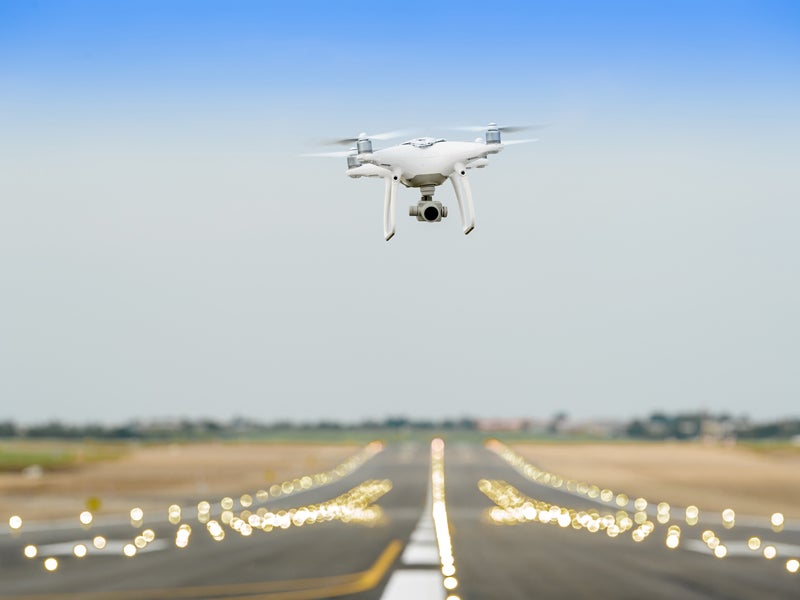
Drones flying over Gatwick Airport caused chaos in December, with hundreds of flights cancelled and tens of thousands of passengers left stranded. The incident has thrown light on just how unprepared airports are when it comes to drone protection. We spoke to security experts to find out how airports should start learning to defend themselves.
We also spoke to the creators of PlaneEnglish, an app-based aviation radio communication simulator that aims to provide an easier way for pilots to acquire radio communication skills, in a market where training opportunities for learning and mastering aviation radio communication can be expensive and few and far between.
Our features writer and myself go head to head over the divisive issue of bringing emotional support animals on board, and finally, we review the latest technology to help blind people navigate the intimidating airport environment in a special audio feature.
Read the issue in full here.
In this issue
In pictures: Chicago O’Hare’s new mega terminal
In January this year, the Chicago Department of Aviation invited the public to vote on a key renovation project for the city, a new terminal at its iconic Chicago O’Hare Airport. Members of the public were asked to pick one of five designs outlining the new $8.5bn terminal as part of the most important renovation works in the airport’s history. Adele Berti looks at each of the striking designs ahead of the final vote.
Read the article here.
Speaking plane English: how a new app is helping pilots and ATC communicate
Training opportunities for learning and mastering aviation radio communication can be expensive and few and far between. However, the creators of PlaneEnglish – an app-based aviation radio communication simulator – aim to provide an easier way for pilots to acquire radio communication skills. Frances Marcellin speaks to Muharrem Mane, president and co-founder of PlaneEnglish to find out more.
Read the article here.
How well do you really know your competitors?
Access the most comprehensive Company Profiles on the market, powered by GlobalData. Save hours of research. Gain competitive edge.

Thank you!
Your download email will arrive shortly
Not ready to buy yet? Download a free sample
We are confident about the unique quality of our Company Profiles. However, we want you to make the most beneficial decision for your business, so we offer a free sample that you can download by submitting the below form
By GlobalDataGatwick drone crisis: what can we learn from December’s fiasco?
Drones flying over Gatwick Airport caused chaos in December, with hundreds of flights cancelled and tens of thousands of passengers left waiting. The South London airport is now rethinking its anti-drone strategy, with many hubs following its lead. So what can be learned from this fiasco, and what solutions are available to prevent similar disruption from happening again? Adele Berti reports.
Read the article here.
Flying with emotional support animals: a divisive issue
A rarity up until a few years ago, new guidelines from the US Department of Transportation now allow emotional support animals onto the majority of airlines, a decision which has certainly ruffled some feathers. Editor Eva Grey and feature writer Adele Berti discuss the arguments framing the debate.
Read the article here.
How does in-flight WiFi work?
As airlines invest to offer customers the best and fastest WiFi services on board, Frances Marcellin looks at how WiFi is provided and how widespread quality in-flight connectivity could impact the airline industry.
Read the article here.
In pictures: what airport protests can tell us about the role of aviation today
Airports have long been a target for the art of protest. In January, protests erupted against air pollution at Bristol Airport, while across America, TSA employees fought the government shutdown. But what do these protests tell us about how airports are viewed today and can that information help improve the way they operate? Adele Berti finds out.
Read the article here.
Facial recognition at LAX: glimpsing the new face of airport security
Los Angeles Airport recently kicked off a pilot scheme testing the viability of facial recognition as part of its famously strict US border security checks. Gemalto, the company in charge of running the programme, is convinced it will help speed up queues at border checks as well as improve passenger experience. But how does it work and can it ever be implemented on a large scale? Adele Berti finds out.
Read the article here.
Second sight: the tech helping to ensure that blind passengers aren’t left in the dark
Airports represent an intimidating environment for travellers living with blindness or visual impairment, but digital tech is lending a helping hand. What are the challenges of navigating an airport without sight, and how can apps like Aira help to tackle them? Chris Lo reports.
Read the article here.
Next issue | May 2019
India’s civil aviation ministry recently released its ‘Vision 2040’ document, which sets out plans to have two airports in 31 major cities, resulting in 200 airports serving the country by 2040. But just how will such capacity be achieved? We look into India’s grand plans for air travel.
Late January 2019 brought an icy polar vortex to the US, sweeping across the Midwest and Northeast and crippling flight schedules across the region. In this map feature, AIR lays out the most devastating impacts of this frigid weather pattern on airports nationwide.
For those with time to kill, or of a nervous disposition, we set out to find out whether it is possible to find a place to sleep, or at least get some peace and quiet in the famously hectic envrionemtn of an airport.
And finally, to discuss the security landscape in more detail, we spoke to Stephen Cooper OBE, the director of operational solutions at Apstec Systems.



